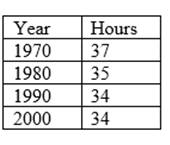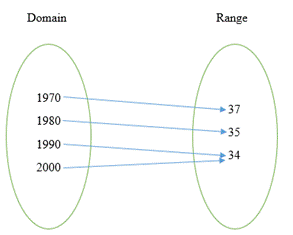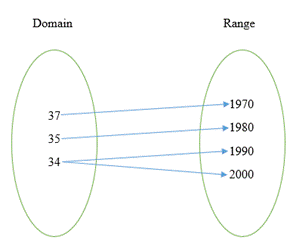
(a)
To write: The values in the table as a set of ordered pairs. Also explain if the data represents a function.
(a)
Answer to Problem 28IP
The values in the table are represented as a set of ordered pairs as follows:
This relation represents a function.
Explanation of Solution
Given information:
The following table:

The values in the table are represented as a set of ordered pairs as follows:
The above relation is a function because each domain value is paired with exactly one range value. If any of the domain values were paired with more than one range values, the given relation would not have qualified as a function.

(b)
To write: Inverse of the ordered pairs of the given data. Also, explain if the obtained data represents a function.
(b)
Answer to Problem 28IP
Inverse of the ordered pairs are represented as follows:
This relation does not represent a function.
Explanation of Solution
Given information:
The following table:

Inverse of the ordered pairs are represented as follows:
The above relation is not a function because

Chapter 9 Solutions
Glencoe Math Accelerated, Student Edition
Additional Math Textbook Solutions
Algebra and Trigonometry (6th Edition)
University Calculus: Early Transcendentals (4th Edition)
Pre-Algebra Student Edition
Basic Business Statistics, Student Value Edition
Elementary Statistics: Picturing the World (7th Edition)
- 1. The average value of f(x) = ✓ on [1,4] and instantaneous rate of change at x = 16 2. f(x) = x³-3x² + 4 Find all relative extrema, inflection point, and the intervals of concavityarrow_forward2. f(x) = x³-3x² +4 Find all relative extrema, inflection point, and the intervals of concavity 5 3. f(x) = 3x3 - 15x3 Find the intervals of increasing, decreasingarrow_forward5 2 3. f(x) = 3x3 - 15x3 Find the intervals of increasing, decreasing 4. If xy+cos y, Findarrow_forward
- #IN A [2 pts.] C 0 II. Consider the circle C r = 4 cos 0 and the line Cr=sec as in the figure on the right. Let A and B be the points of intersection of the two curves as shown. 1. Find the polar coordinates of A and B. 2. Find a Cartesian equation of the tangent line to C at the point where [4 pts.] 3. Set up (and do not evaluate) a definite integral or a sum of definite integrals that yields the follow- ing: a. the length of the portion of C traced counterclockwise from A to B. b. the area of the shaded region. [2 pts.] [3 pts.] B Carrow_forwardI. Perform the following integrations. 1. L' (2x + 1)e³r da cot³ (ln x) csc³ (ln x) 2. dx х 3. 4. x² √1-92 dx 3x3 +14x+7 x² (x²+7) dxarrow_forwardIV. Consider the equation : y + z = 2. 1. Sketch a portion of the graph of π in the first octant in R3. Indicate proper rulings. [2 pts.] 2. Find an equation of the surface generated by revolving the trace of π on the the yz-plane about the y-axis. Sketch the surface of revolution. [3 pts.]arrow_forward
- IV. Consider the function f(x) = esin 2x 1. Find the second-degree Maclaurin polynomial of f(x). 2. Approximate esin 0.02 using the result in IV.1. Express your answer in decimal form.arrow_forwardIII. Find the center-radius form of the equation of the sphere having the line segment with endpoints P(1,-2, 1) and Q(5, 0, 1) as a diameter. [2.5 pts.]arrow_forwardII. Determine if the improper integral is convergent or divergent. 0 2x2 L dx -2 x3+8arrow_forward
- 2+5n2 1. Determine whether the sequence (b) converges or diverges. 2. Determine whether the following series converge or diverge. State the test you us 3n² - n I. Let bn = for n N with n ≥ 1. نے n=1 8 b. (bn)" n=1arrow_forwardII. Determine whether the following series converge or diverge. State the test you used. (4/2/3 po 1 1. n(Inn)2 n=3 2. 8 IM n=1 5" + sin² n 3n 00 1.3 " 3. (2n − 1) (n + 2)! - n=1arrow_forward7. Consider the following parametric curve: x = sint, y = 2 cost, for 0 ≤t≤ a) Eliminate the parameter to find a rectangular equation for the curve. b) Use the parametric equations to find the slope of the tangent line when t = c) Use the parametric equations to set up an integral to represent the arc length of the curve. You do not need to evaluate the integral.arrow_forward
 Calculus: Early TranscendentalsCalculusISBN:9781285741550Author:James StewartPublisher:Cengage Learning
Calculus: Early TranscendentalsCalculusISBN:9781285741550Author:James StewartPublisher:Cengage Learning Thomas' Calculus (14th Edition)CalculusISBN:9780134438986Author:Joel R. Hass, Christopher E. Heil, Maurice D. WeirPublisher:PEARSON
Thomas' Calculus (14th Edition)CalculusISBN:9780134438986Author:Joel R. Hass, Christopher E. Heil, Maurice D. WeirPublisher:PEARSON Calculus: Early Transcendentals (3rd Edition)CalculusISBN:9780134763644Author:William L. Briggs, Lyle Cochran, Bernard Gillett, Eric SchulzPublisher:PEARSON
Calculus: Early Transcendentals (3rd Edition)CalculusISBN:9780134763644Author:William L. Briggs, Lyle Cochran, Bernard Gillett, Eric SchulzPublisher:PEARSON Calculus: Early TranscendentalsCalculusISBN:9781319050740Author:Jon Rogawski, Colin Adams, Robert FranzosaPublisher:W. H. Freeman
Calculus: Early TranscendentalsCalculusISBN:9781319050740Author:Jon Rogawski, Colin Adams, Robert FranzosaPublisher:W. H. Freeman
 Calculus: Early Transcendental FunctionsCalculusISBN:9781337552516Author:Ron Larson, Bruce H. EdwardsPublisher:Cengage Learning
Calculus: Early Transcendental FunctionsCalculusISBN:9781337552516Author:Ron Larson, Bruce H. EdwardsPublisher:Cengage Learning





